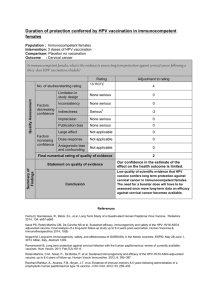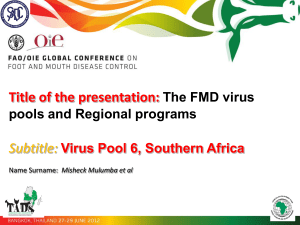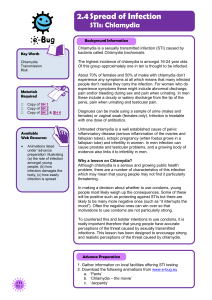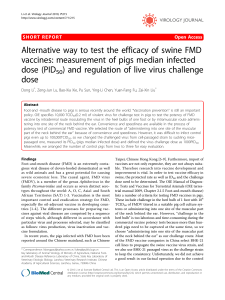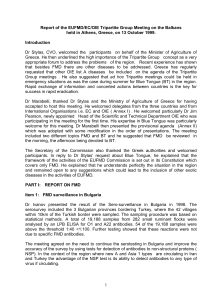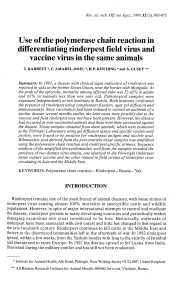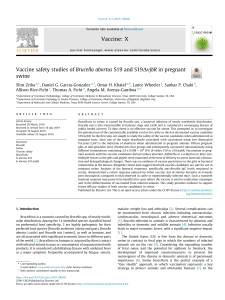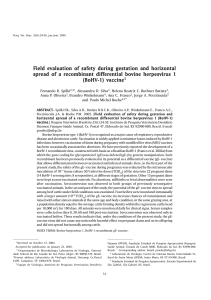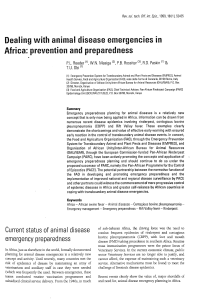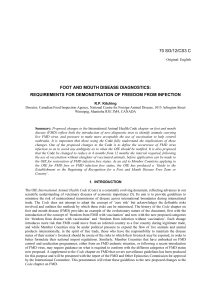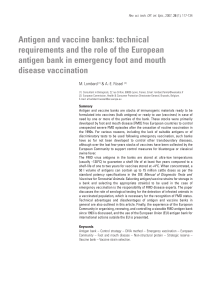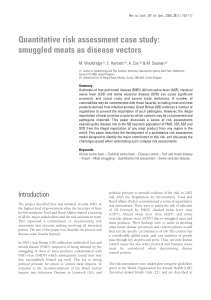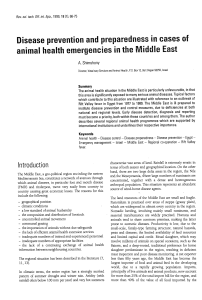D11273.PDF
publicité
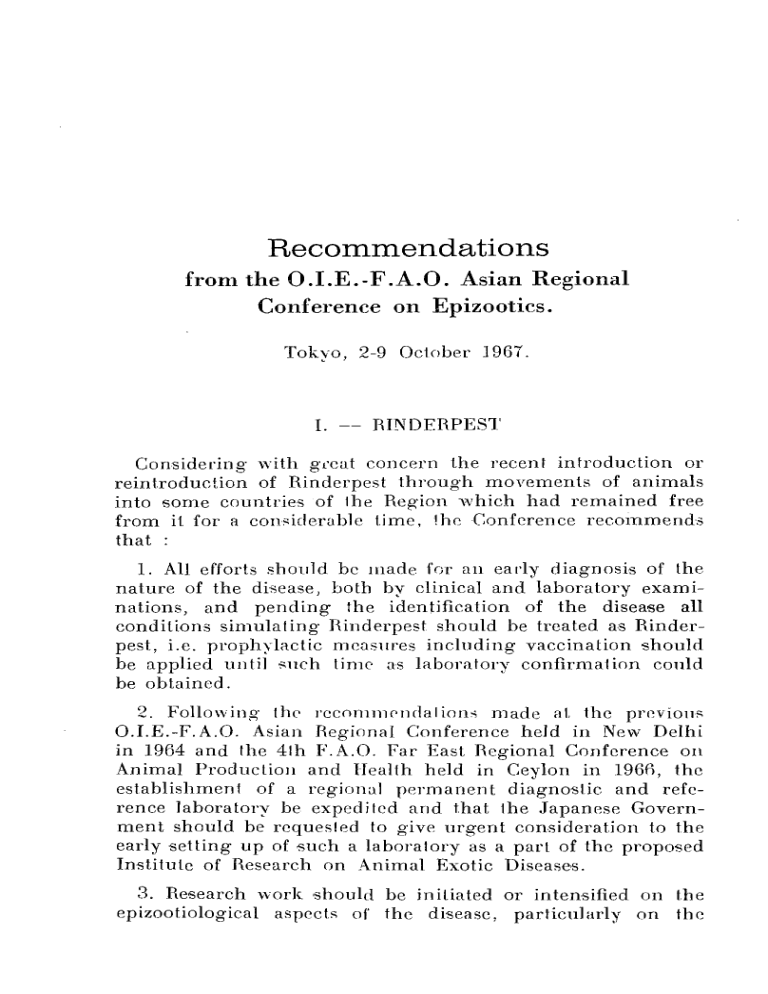
Recommendations from the O.I.E.-F.A.O. Asian Regional Conference on Epizootics. Tokyo, 2-9 October 1967. I. — RINDERPEST Considering with great concern the recent introduction or reintroduction of Rinderpest through movements of animals into some countries of the Region which had remained free from it for a considerable lime, the Conference recommends that : 1. All efforts should be made for an early diagnosis of the nature of the disease, both by clinical and laboratory examinations, and pending the identification of the disease all conditions simulating Rinderpest should be treated as Rinderpest, i.e. prophylactic measures including vaccination should be applied until such time as laboratory confirmation could be obtained. 2. Following the recommendations made at the previous O.I.E.-F.A.O. Asian Regional Conference held in New Delhi in 1964 and the 4lh F.A.O. Far East Regional Conference on Animal Production and Health held in Ceylon in 1966, the establishment of a regional permanent diagnostic and reference laboratory be expedited and that the Japanese Government should be requested to give urgent consideration to the early setting up of such a laboratory as a part of the proposed Institute of Research on Animal Exotic Diseases. 3. Research work should be initiated or intensified on the epizootiological aspects of the disease, particularly on the — 353 — identification of virus reservoirs in species of animals regarded so far as insusceptible or less susceptible to the infection than the normal susceptible species. 4. Close and effective collaborative efforts should be made by neighbouring countries to ensure that simultaneous prophylactic measures including vaccination are taken on frontiers in order to prevent the introduction or reintroduction of the disease from one country to another. 5. For an effective and early eradication of Rinderpest from the entire Region and in order to prevent introduction or reintroduction of the infection into countries free from it, the internal reporting system should be improved and an immediate notification of outbreaks or suspected outbreaks should be made to O.I.E., F.A.O. and neighbouring countries. Irrespective of the immediate trade interests of the countries concerned, Governments should be requested to authorise notification of new outbreaks in order to create and maintain confidence in the importing countries, promote long term trade interests and help in the safe and healthy development of the livestock industry in the Region. II. — FOOT-AND-MOUTH DISEASE Considering the increasing of Foot-and-Mouth Disease in the Region, particularly in countries where intensive cattle and buffalo breeding is systematically practised, and where a dairy industry is rapidly developing and also the growing risks through movements of animals and animal products of introducing the infection into countries previously free from it, the Conference recommends that : 1. All countries which have remained free from infection should enforce strict prophylactic measures including quarantine to prevent its introduction into their territories. 2. Infected countries should make every effort to establish an early diagnosis and typing of responsible strain (s) in the specialised laboratories existing in the Region, such as the Indian Veterinary Research Institute, Mukteswar, India; the Razi Institute, Hessarek, Iran; the FMD Institute, Nong Sarai, Thailand; as well as the FMD World Reference Laboratory, Pirbright, United Kingdom. Every precaution 12 — 354 — recommended by Pirbright for the shipment of suspected samples should be adhered to. 3. The above laboratories, as well as any other specialised laboratory engaged in the typing and study of strains isolated in the Region should exchange between themselves inactivated antisera prepared from regional strains with a view to comparing them and producing a vaccine from the most suitable type (s). 4. Infected countries in the Region should initiate or expand wherever necessary vaccination programmes as a first priority to cover all valuable breeding stock and to establish buffer zones along their borders, using only inactivated vaccine, prepared from strains isolated preferably in the countries concerned or at least in the Region. 5. Animals imported for breeding purposes from countries free from FMD or infected with types of virus different from those already existing in the importing countries, should be vaccinated in a quarantine station of the latter countries, with an inactivated vaccine prepared from strains isolated preferably in the countries concerned or at least in the Region. The imported animals should be kept in quarantine in the importing countries for a m i n i m u m period of three weeks. 6. For economical reasons, further research work in the laboratory on the possible combination of FMD vaccine with other vaccine (s) for the protection of livestock against various infections should be encouraged. 7. Full advantage should be taken by countries both free and infected to utilise the reference laboratories already existing to send some of their laboratory research workers for training in the techniques of diagnosis, typing and vaccine production against FMD. III. — PASTEURELLOSIS Considering that pasteurellosis is of great importance in the Region, particularly in buffaloes and cattle, the Conference recommends that : 1. The veterinary authorities of the countries concerned should make every effort to have samples collected in the — 355 — field submitted to a precise laboratory diagnosis and make all facilities available to their national laboratories to enable them to carry out this work. 2. The typing of strains responsible for outbreaks should be effected wherever the infection is present, by laboratories of the Region specialised in this, with a view to preparing the most suitably antigenic vaccine. 3. Wherever pasteurellosis is suspected in swine, confirmation should always be made by laboratory diagnosis. 4. Large scale immunization with vaccines prepared in the different laboratories of the Region should be made, bearing in mind the seasonal occurrence of the infection and preference should be given wherever possible to oil adjuvant vaccine which has been proved to confer a longer immunity. IV. — SWINE DISEASES Considering that Hog cholera remains by far the most important of Swine Diseases in the Region in spite of the advances of laboratory techniques on diagnosis and vaccine production, the Conference recommends that : 1. For an early diagnosis of the disease, a greater use should be made of recently developed diagnostic techniques such as the immuno-fluorescence on tissue culture and other serological methods. Every advantage should be taken of facilities available in some laboratories in the Region for training laboratory workers in those techniques and methods. 2. A systematic survey of field strains of different virulence in the Region and a careful study of their respective immunological behaviour in relation to existing vaccines be carried out. 3. Wherever final eradication of the disease is sought, inactivated vaccines should be used only, whereas in countries where an efficient control only is required, attenuated vaccines should be applied. Moreover, efforts to develop a fully reliable attenuated vaccine incapable of spreading the infection should be encouraged wherever feasible. — 356 Y. — AVIAN DISEASES Considering that Newcastle Disease has now disseminated widely within the Region and losses from this disease are greater than from all other avian diseases, and in view of the fact that the prevention of Newcastle Disease should be the most important of all avian disease control programmes, the Conference recommends that : 1. Each country should provide proper facilities and the necessary funds to initiate or intensify essential research work to control more efficiently Newcastle Disease. 2. Each country must become aware of the urgent need for reliable and repeated evaluation of Newcastle Disease vaccines. 3. In countries where Newcastle disease is enzootic, research should be initiated or intensified to determine in view of the presence of maternal antibodies in baby chicks, the suitable times for vaccination and types of vaccine. VI. — PARASITIC DISEASES OF LIVESTOCK Considering that fascioliasis, parasitic gastroenteritis, arthropod-borne diseases, particularly anaplasmosis, babesiosis, theileriosis, trypanosomiasis (T. evansi) in horses and cattle, avian coccidiosis and toxoplasmosis of swine are the most important parasitic diseases in the Region, the Conference recommends that : 1. Mass treatment in fascioliasis and parasitic gastroenteritis as well as prophylaxis should be extensively encouraged, as well as investigation on the biological transmission of these conditions. 2. Further studies on the immunization in parasitic (helminthic and protozoan) diseases should be carried out in the countries wherever these diseases are prevalent and laboratory facilities for undertaking this work are available. 3. In view of the fact that toxoplasmosis in swine is an emerging and important zoonosis in some countries of the Region, countries with large pig populations should under- — 357 — take surveys of the incidence of this infection. Further studies on the effective diagnosis and treatment of this condition in swine, as well as the nature of potential reservoirs in the wildlife be carried out. VII. — RABIES Considering with great concern the continuing spread of infection by wild animals and the resulting difficulties in the control of the disease, the Conference recommends that : 1. In view of the frequent incidence of the Rabies virus confirmed in wild animals which accounts for the spread of the infection in domestic animals and man, ecological investigations should be carried out and a systematic control of the former species of animals should be undertaken wherever possible. 2. Countries of the Region should take into consideration the recommendations from the 4th F.A.O. Far East Regional Conference on Animal Production and Health, held in Ceylon in October 1966 and of the O.I.E.-W.H.O.-F.A.O. Meeting on Rabies, held in Paris in February 1967 that they should make use of the fluorescent antibodies technique for the rapid diagnosis of Rabies, bearing in mind, however, that this method requires adequate training of staff and essential safeguard to maintain the accurate testing standard and interpretation.



